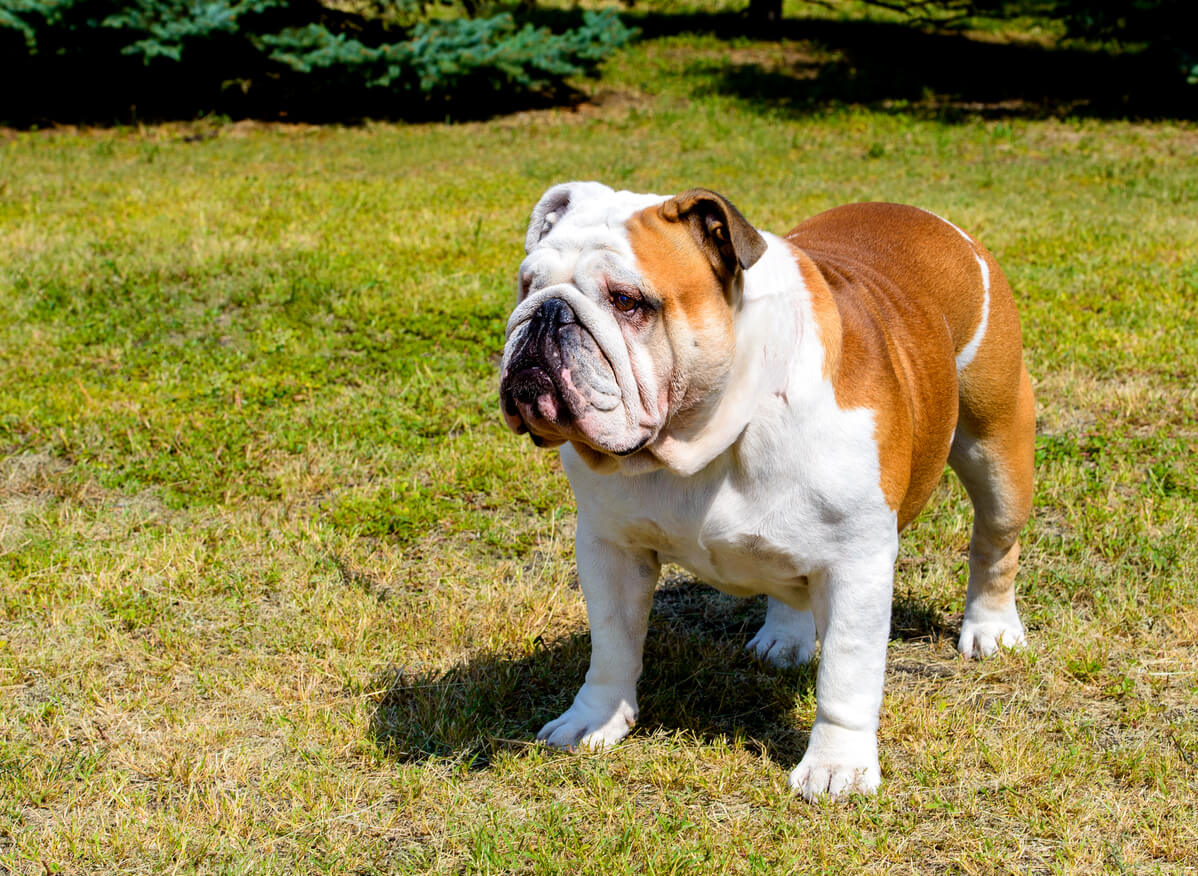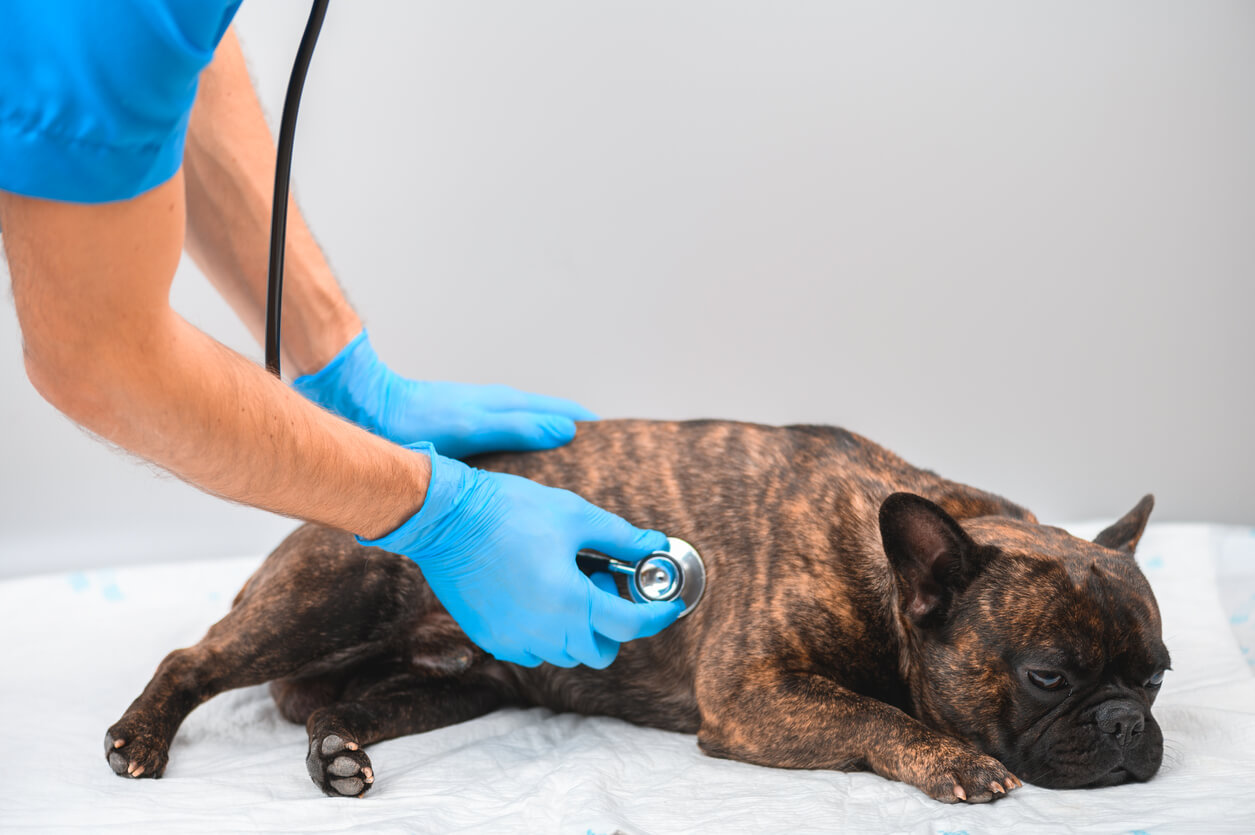All About Hemivertebra in Brachycephalic Dogs

Due to their anatomical characteristics, brachycephalic dogs are predisposed to suffer a series of specific pathologies throughout their lives. One of the most relevant is the hemivertebra, a congenital malformation that affects the welfare of pets that suffer from it.
Considering that breeds such as the bulldog have become very popular in recent years, it’s important for people to get to know all aspects related to one of the most prevalent skeletal disorders in this type of dog. For this reason, we’re going to tell you all about the origin, symptoms, diagnosis, and possible treatment of hemivertebra in brachycephalic dogs. Don’t miss it!
What are brachycephalic dogs?
They’re dogs with well-defined and distinctive physical features. Among the most outstanding characteristics are the following:
- A circular skull
- Short or flattened muzzle
- Narrow nostrils
- Bulging eyes
- Soft and elongated palate
- Solid bodies and short limbs
- Curled tail
Although these attributes are noticeable in some breeds, the reality is that there’s scientific evidence that many of these anatomical peculiarities predispose to the appearance of intermuscular, respiratory, cardiac, ocular and digestive diseases.
In an effort to achieve these types of characteristics in dogs, breeders have used harmful reproductive selection techniques such as inbreeding; that is, crossing close relatives.
In fact, according to a study published in the journal Frontiers in Veterinary Science, brachycephalic dogs are 3.3 times more likely to give birth to neonates with congenital malformations than dogs of other types of breeds. Of these anomalies, the hemivertebra is one of the most common and of greater importance in the area of veterinary medicine.

What is hemivertebra?
A hemivertebra is the deformation of one or more of the vertebral bodies that compose the spine. To be more precise, the vertebra presents an incomplete formation or absence of a part, which leads it to acquire a wedge or triangle shape.
It usually appears in the thoracic area, and depending on its conformation, it can cause a dorsal or lateral curvature of the spine. That is, kyphosis or scoliosis.
Its origin is embryonic, as it develops during the early stages of neonatal growth. It is suggested that it is caused by problems of vascularization or ossification of the vertebrae during this stage, which generates the malformation of the vertebrae.
Although it can appear in any type of dog, brachycephalic breeds are more predisposed due to the heritability of recessive genes resulting from inbreeding.
Symptoms of hemivertebrae in dogs
Due to the anatomical conformation of the hemivertebra, in most cases, direct pressure is generated on the spinal cord. Therefore, the clinical signs are similar to those produced by neurological damage.
Accordingly, symptoms include:
- Pain on palpation
- Ataxia
- Weakness or paralysis of the hind limbs
- Fecal and urinary incontinence (in more severe cases)
In addition, when there’s kyphosis in the spine, other problems such as degeneration or herniation of the intervertebral disc can be generated. These clinical manifestations begin very early, usually between 4 to 10 months of age.
However, it’s important to note that not all dogs with hemivertebrae develop this type of neurological symptomatology. That’s to say, some live with this malformation all their lives without neurological signs.
However, according to a study shared in the journal Veterinary Radiology & Ultrasound, within the brachycephalics, the pug is 10 times more likely to develop neurological signs when suffering from hemivertebra than other breeds such as the French bulldog or the English bulldog.
Diagnosis
The diagnosis of this pathology is based on a physical examination of the patient and on the evaluation of the anamnesis. In addition, it’s important to complement it with the use of diagnostic imaging such as lateral and dorsoventral radiographs.
If possible, computed tomography (CT) and magnetic resonance imaging (MRI) are recommended to identify the extent of the lesion on the spinal cord.

Treatment
The only resolution of this pathology is surgical intervention. However, it is only recommended in cases in which the spinal cord is involved.
Surgeries aim to decompress and stabilize the spine, using techniques such as laminectomy or hemilaminectomy and the use of screws or threaded pins to fix the spine.
In most cases, dogs who undergo these interventions report a satisfactory recovery. However, it’s also reported that some show chronic complications, However, these are of minor relevance, such as pain and swelling.
Finally, it’s advisable to identify this type of malformation at an early age, because as time goes by, the approach becomes more complicated.
In summary
As you can tell, hemivertebra is a pathology that puts pets’ health at risk. Above all, it affects brachycephalic breeds, which are popular nowadays.
Although the objective isn’t to condemn people who acquire them, it is important that you ask yourself if you’re prepared to deal with the diseases that accompany this type of dog. If this isn’t the case, then it’s best to adopt or buy dogs that don’t have so many degrees of inbreeding.
Finally, if your dog suffers from hemivertebra, we would encourage you not to breed them. In this way, the genes causing the disease won’t be transmitted to the following generations.
All cited sources were thoroughly reviewed by our team to ensure their quality, reliability, currency, and validity. The bibliography of this article was considered reliable and of academic or scientific accuracy.
- Bannasch, D., Famula, T., Donner, J., Anderson, H., Honkanen, L., Batcher, K., Safra, N., Thomasy, S., & Rebhun, R. (2021). The effect of inbreeding, body size and morphology on health in dog breeds. Canine Medicine and Genetics, 8(1), 12. https://cgejournal.biomedcentral.com/articles/10.1186/s40575-021-00111-4
- Bertram, S., Ter Haar, G., & De Decker, S. (2019). Congenital malformations of the lumbosacral vertebral column are common in neurologically normal French Bulldogs, English Bulldogs, and Pugs, with breed-specific differences. Veterinary Radiology & Ultrasound: the official journal of the American College of Veterinary Radiology and the International Veterinary Radiology Association, 60(4), 400–408. https://onlinelibrary.wiley.com/doi/10.1111/vru.12753
- De Decker, S., Packer, R. M. A., Cappello, R., Harcourt-Brown, T. R., Rohdin, C., Gomes, S. A., Bergknut, N., Shaw, T. A., Lowrie, M., & Gutierrez-Quintana, R. (2019). Comparison of signalment and computed tomography findings in French Bulldogs, Pugs, and English Bulldogs with and without clinical signs associated with thoracic hemivertebra. Journal of Veterinary Internal Medicine, 33(5), 2151–2159. https://onlinelibrary.wiley.com/doi/10.1111/jvim.15556
- Dewey, C. W., Davies, E., & Bouma, J. L. (2016). Kyphosis and Kyphoscoliosis Associated with Congenital Malformations of the Thoracic Vertebral Bodies in Dogs. The Veterinary clinics of North America. Small Animal Practice, 46(2), 295–306. https://www.sciencedirect.com/science/article/abs/pii/S0195561615001667?via%3Dihub
- Duarte, A. (2020). Anomalías vertebrales congénitas. Diagnóstico Veterinario. Consultado el 10 de mayo de 2023. https://www.diagnosticoveterinario.com/anomalias-vertebrales-congenitas/7733?utm_content=expand_article
- Estevam, M. V., Beretta, S., Smargiassi, N. F., Apparício, M., Toniollo, G. H., & Pereira, G. T. (2022). Congenital malformations in brachycephalic dogs: A retrospective study. Frontiers in Veterinary Science, 9, 981923. https://www.ncbi.nlm.nih.gov/pmc/articles/pmid/36268051/
- Jeffery, N. D., Smith, P. M., & Talbot, C. E. (2007). Imaging findings and surgical treatment of hemivertebrae in three dogs. Journal of the American Veterinary Medical Association, 230(4), 532–536. https://avmajournals.avma.org/view/journals/javma/230/4/javma.230.4.532.xml
- Mavrides, D., Charalambous, M., & Freeman, P. (2021). Long-term follow-up of spinal segmental stabilization for surgical treatment of dorsal hemivertebrae associated with kyphosis in brachycephalic dogs. The Canadian veterinary journal = La revue veterinaire canadienne, 62(12), 1323–1327. https://www.ncbi.nlm.nih.gov/pmc/articles/PMC8591567/
- Moissonnier, P., Gossot, P., & Scotti, S. (2011). Thoracic kyphosis associated with hemivertebra. Veterinary Surgery : VS, 40(8), 1029–1032. https://onlinelibrary.wiley.com/doi/10.1111/j.1532-950X.2011.00876.x
- O’Neill, D. G., Skipper, A., Packer, R. M. A., Lacey, C., Brodbelt, D. C., Church, D. B., & Pegram, C. (2022). English Bulldogs in the UK: a VetCompass study of their disorder predispositions and protections. Canine Medicine and Genetics, 9(1), 5. https://cgejournal.biomedcentral.com/articles/10.1186/s40575-022-00118-5#citeas
- Rohdin, C., Häggström, J., Ljungvall, I., Nyman Lee, H., De Decker, S., Bertram, S., Lindblad-Toh, K., & Hultin Jäderlund, K. (2018). Presence of thoracic and lumbar vertebral malformations in pugs with and without chronic neurological deficits. Veterinary journal (London, England: 1997), 241, 24–30. https://www.sciencedirect.com/science/article/abs/pii/S1090023318305598
- Ryan, R., Gutierrez-Quintana, R., Haar, G. T., & De Decker, S. (2019). Relationship between breed, hemivertebra subtype, and kyphosis in apparently neurologically normal French Bulldogs, English Bulldogs, and Pugs. American Journal of Veterinary Research, 80(2), 189–194. https://avmajournals.avma.org/view/journals/ajvr/80/2/ajvr.80.2.189.xml
- Sánchez, L., & Portiansky, E. (2017). Anomalías del desarrollo en razas braquicéfalas: anatomía aplicada y cirugía reparadora. Conference: Jornadas Internacionales de Veterinaria Práctica. https://www.researchgate.net/publication/319213331_ANOMALIAS_DEL_DESARROLLO_EN_RAZAS_BRAQUICEFALAS_ANATOMIA_APLICADA_Y_CIRUGIA_REPARADORA
- Schlensker, E., & Distl, O. (2016). Heritability of hemivertebrae in the French bulldog using an animal threshold model. Veterinary Journal (London, England: 1997), 207, 188–189. https://www.sciencedirect.com/science/article/abs/pii/S1090023315004554?via%3Dihub
This text is provided for informational purposes only and does not replace consultation with a professional. If in doubt, consult your specialist.